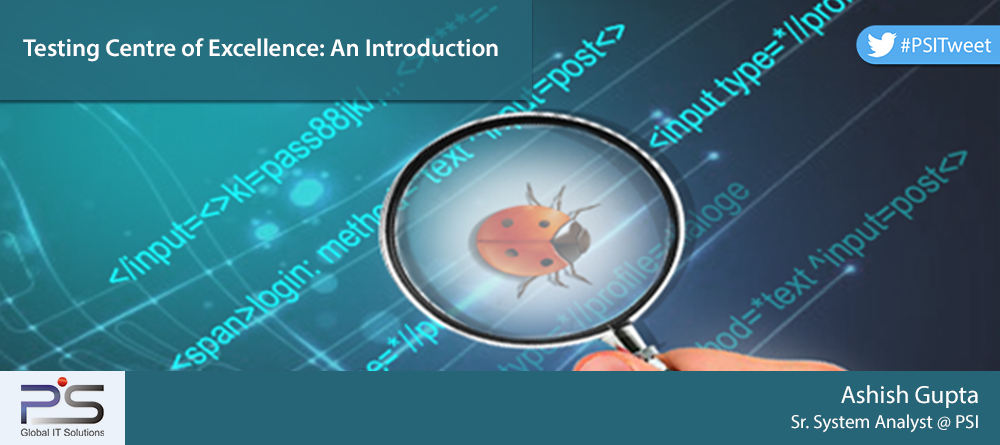In modern business environment, one of the biggest challenge for organizations is shrinking budgets and increased cost pressures. Project teams are expected to deliver high quality IT solutions with low cost and less time, with fewer resources to provide an early return on investment and tinier time to market.
These challenges are putting extreme pressure on QA activities and processes. With time traditional QA practices have become unsuccessful to meet and resolve these challenges, so organizations are now working on developing independent Testing Centre of Excellence (TCoE).
These challenges are putting extreme pressure on QA activities and processes. With time traditional QA practices have become unsuccessful to meet and resolve these challenges, so organizations are now working on developing independent Testing Centre of Excellence (TCoE).
What is a TCoE?
Testing Centre of Excellence (TCoE) is a model for centralized testing platform that provides for standardizing testing processes and optimal utilization of testing resources. It brings the people, process, knowledge, infrastructure, tools and technologies together to deal with these challenges and achieve excellence in testing functions.
Comparison between Traditional QA process and TCoE
| Traditional QA Process | TCoE |
|---|---|
| No Standardized Test process is adapted within the organization. | Optimized Test process is followed in organization. |
| Teams don’t have the supporting mechanism to share and reuse the assets, knowledge and infrastructure. | Reuse artifacts such as templates, frameworks, test cases, metrics etc. |
| Minimum visibility into application quality across projects. | Centralized Testing Metrics provide maximum visibility over quality across projects. |
| Test efficiency across the projects cannot be measured and hence cannot be managed. | Govern testing activities by using metrics and SLAs. |
| No single point of ownership to manage the entire set up | Team is a key element where each team member will have responsibilities and expectation defined. |
| Cannot ensure a consistent quality across the organization as they are controlled by different management teams | Centralized delivery for testing with shared resources and ability to run it as managed service that
|
Additional advantages of TCoE
TCoE implementation helps the organizations in:
- Adapting to new changes in technology and deliver the application fast.
- Shared resources mean more specialist skills are affordable.
- Assign appropriate resources to test complex applications.
- Accurate estimation of an application.
- Timely delivery of an application to client.
- Centralised expertise and knowledge development – both of business / system knowledge but also of testing knowledge.
- Building quality standards in the development phase itself.
- Keeping a common way of accessing, reusing and sharing all the documentations required for different phases of delivering an application.
- Identify opportunities for improvement and thereby improving the quality process.
- Reduce number of defects in early stages.
Key Elements of a TCoE
- Team: The most important element of TCoE is to have a team in place to deal with incoming project requirements. It is expected that the each individual in the team has the desired skills, in order to provide long-term value to its customers. The following are the typical roles in a TCoE, which also depends on the organisation structure, and particularly the projects:
- Test Managers
- Test Architects
- Test Leads
- Test Automation Engineers
- Performance Specialists
- Business Analysts
- Process and Documentation: Forming a primary set of standard documentation and a common methodology to test for different projects is another key element of the TCoE. The major document required is Test Strategy. Depending on the organization size and the amount of projects it caters, will decide whether one or multiple test strategies are required. Some organizations have a top level Test Policy document, which defines the high level objectives of testing, and are supported by one of more Test Strategy documents. Having a well-defined Test Strategy in place is fundamental to achieve success in testing.Metrics are also equally important to collect statistics like cycles of testing, estimate vs actual timescales, defects opened/fixed/closed per sprint or by release or by cycle. Recording and analysis of metrics will help in measuring ROI and success of the Testing Centre.
- Tools: Choosing the correct tools is important for any testing team but even more important when implementing a TCoE in Organization. The tool types to be included are:
- Test Management
- Unit Testing
- Functional Testing Automation
- Performance Testing
- Security Testing
- Others – include data management, database query, CI tools etc.
TCoE Implementation Phases
Phase 1 – Define and setup Governance Process
- Determine the quality standards
- Implement the initial governance process
- Establish fundamentals for application testing
- Define elementary reporting techniques
Phase 2 – Setup Test Infrastructure Utility
- Determine the testing methods such as checklists and tools procurement.
- Setting up Test environment and estimating its maintenance cost.
- Develop QA team on Tools and if needed, get them certified from authorised body.
Phase 3 – Service Utility and flexible resource pool
- TCoE provides centralized services for entire organization.
- Include projects and the domain experts, shared services team etc. for dedicated testing activities.
Phase 4 – Establish the Steady State
- Functions as a service provider to project teams and take complete ownership of QA.
- Offers testing resources, tools and methodologies for testing of applications and cross functional business processes.
Conclusion
TCoE is a way to move forward, improve the quality of the applications and deliver enhanced value to both internal & external business units. It increases the overall maturity of testing & optimize the testing costs across the enterprise. Moreover the TCoE framework assists management to measure and showcase the resource-brilliance and expertise the IT organisation possesses.In modern business environment, one of the biggest challenge for organizations is shrinking budgets and increased cost pressures. Project teams are expected to deliver high quality IT solutions with low cost and less time, with fewer resources to provide an early return on investment and tinier time to market.
These challenges are putting extreme pressure on QA activities and processes. With time traditional QA practices have become unsuccessful to meet and resolve these challenges, so organizations are now working on developing independent Testing Centre of Excellence (TCoE).
These challenges are putting extreme pressure on QA activities and processes. With time traditional QA practices have become unsuccessful to meet and resolve these challenges, so organizations are now working on developing independent Testing Centre of Excellence (TCoE).
What is a TCoE?
Testing Centre of Excellence (TCoE) is a model for centralized testing platform that provides for standardizing testing processes and optimal utilization of testing resources. It brings the people, process, knowledge, infrastructure, tools and technologies together to deal with these challenges and achieve excellence in testing functions.
Comparison between Traditional QA process and TCoE
| Traditional QA Process | TCoE |
|---|---|
| No Standardized Test process is adapted within the organization. | Optimized Test process is followed in organization. |
| Teams don’t have the supporting mechanism to share and reuse the assets, knowledge and infrastructure. | Reuse artifacts such as templates, frameworks, test cases, metrics etc. |
| Minimum visibility into application quality across projects. | Centralized Testing Metrics provide maximum visibility over quality across projects. |
| Test efficiency across the projects cannot be measured and hence cannot be managed. | Govern testing activities by using metrics and SLAs. |
| No single point of ownership to manage the entire set up | Team is a key element where each team member will have responsibilities and expectation defined. |
| Cannot ensure a consistent quality across the organization as they are controlled by different management teams | Centralized delivery for testing with shared resources and ability to run it as managed service that
|
Additional advantages of TCoE
TCoE implementation helps the organizations in:
- Adapting to new changes in technology and deliver the application fast.
- Shared resources mean more specialist skills are affordable.
- Assign appropriate resources to test complex applications.
- Accurate estimation of an application.
- Timely delivery of an application to client.
- Centralised expertise and knowledge development – both of business / system knowledge but also of testing knowledge.
- Building quality standards in the development phase itself.
- Keeping a common way of accessing, reusing and sharing all the documentations required for different phases of delivering an application.
- Identify opportunities for improvement and thereby improving the quality process.
- Reduce number of defects in early stages.
Key Elements of a TCoE
- Team: The most important element of TCoE is to have a team in place to deal with incoming project requirements. It is expected that the each individual in the team has the desired skills, in order to provide long-term value to its customers. The following are the typical roles in a TCoE, which also depends on the organisation structure, and particularly the projects:
- Test Managers
- Test Architects
- Test Leads
- Test Automation Engineers
- Performance Specialists
- Business Analysts
- Process and Documentation: Forming a primary set of standard documentation and a common methodology to test for different projects is another key element of the TCoE. The major document required is Test Strategy. Depending on the organization size and the amount of projects it caters, will decide whether one or multiple test strategies are required. Some organizations have a top level Test Policy document, which defines the high level objectives of testing, and are supported by one of more Test Strategy documents. Having a well-defined Test Strategy in place is fundamental to achieve success in testing.Metrics are also equally important to collect statistics like cycles of testing, estimate vs actual timescales, defects opened/fixed/closed per sprint or by release or by cycle. Recording and analysis of metrics will help in measuring ROI and success of the Testing Centre.
- Tools: Choosing the correct tools is important for any testing team but even more important when implementing a TCoE in Organization. The tool types to be included are:
- Test Management
- Unit Testing
- Functional Testing Automation
- Performance Testing
- Security Testing
- Others – include data management, database query, CI tools etc.
TCoE Implementation Phases
Phase 1 – Define and setup Governance Process
- Determine the quality standards
- Implement the initial governance process
- Establish fundamentals for application testing
- Define elementary reporting techniques
Phase 2 – Setup Test Infrastructure Utility
- Determine the testing methods such as checklists and tools procurement.
- Setting up Test environment and estimating its maintenance cost.
- Develop QA team on Tools and if needed, get them certified from authorised body.
Phase 3 – Service Utility and flexible resource pool
- TCoE provides centralized services for entire organization.
- Include projects and the domain experts, shared services team etc. for dedicated testing activities.
Phase 4 – Establish the Steady State
- Functions as a service provider to project teams and take complete ownership of QA.
- Offers testing resources, tools and methodologies for testing of applications and cross functional business processes.
Conclusion
TCoE is a way to move forward, improve the quality of the applications and deliver enhanced value to both internal & external business units. It increases the overall maturity of testing & optimize the testing costs across the enterprise. Moreover the TCoE framework assists management to measure and showcase the resource-brilliance and expertise the IT organisation possesses.[:]









